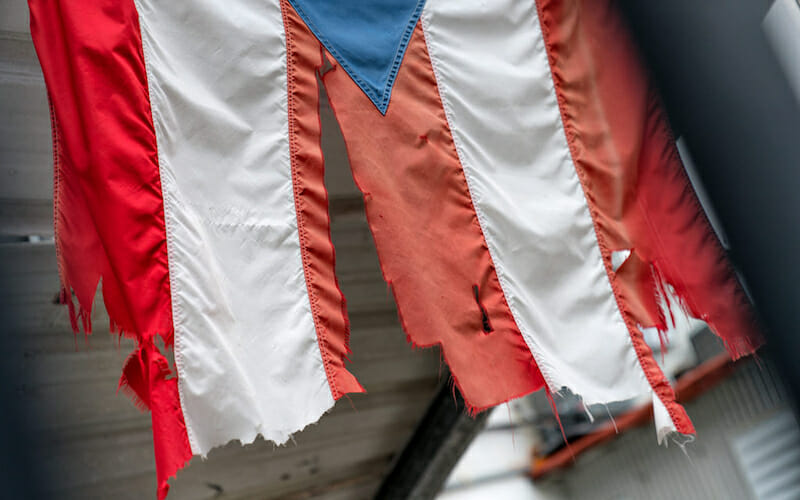
With Puerto Rico, Congress Has No Leg to Stand On
Puerto Rican officials came under the gun last week as Congress criticized their efforts to get the territory back on its feet in the aftermath of Hurricane Maria. Speaking at a hearing conducted by the House Energy and Natural Resources Committee, chairman Rob Bishop lambasted Governor Ricardo Rosselló and then-power authority chief Ricardo Ramos for mismanaging attempts to restore the island’s fragile grid.
While the criticisms themselves may be solid, the condemnatory tone taken by Congress conveniently ignores Capitol Hill’s own sluggishness in addressing the crisis. Two months on from the biggest disaster in Puerto Rico’s history, half of the island’s residents – almost two million American citizens – still lack power.
Fortunately, the private sector has stepped in to carry out disaster recovery efforts. Even now, private donors, businesses, and private aviation hubs shoulder much of the financial and logistical burden. Washington can criticize, but it also needs to acknowledge its share of the blame when it comes to Puerto Rico’s ongoing crisis.
When Maria knocked out the island’s power lines on September 20th – plunging the whole population into complete darkness – the territory had been expected to fall back upon a network of mutual aid utilities, as states and municipalities normally do when such disasters occur.
Instead, Rosselló announced a private deal with a tiny contracting company named Whitefish Energy (from the Interior Secretary’s hometown), which was scrapped after being found to be riddled with inconsistencies. On the heels of the scandal, Bishop lambasted the power authority as responsible for “a legacy of dysfunction” that had led to “a competence deficit,” calling for new administrative powers to be given to the Financial Oversight Management Board to regulate the territory’s transactions.
The wisdom of the Whitefish deal aside, the federal government’s own efforts have also been far too limited to reach those most in need. For one thing, after the hurricane first struck, it took President Trump a full five days to tweet about the disaster, let alone act on it. When they did land, his words were more critical than compassionate, citing Puerto Rico’s indebtedness as citizens were dying.
For the sake of comparison, a $10.5 billion relief package was announced for New Orleans just four days after Hurricane Katrina hit the city in 2005. A $7.9 billion one was approved for Texas shortly after Hurricane Harvey earlier this year.
In contrast, it took Congress eight days to take the minimum step of temporarily waiving restrictions under the Jones Act, which limited which ships could deliver relief supplies to Puerto Rico, and a full two weeks to pass a $36.5 billion disaster relief package.
As a result of the government’s inaction, the private sector has now become the most critical lifeline for Puerto Ricans after the storm. Sonnen, an energy storage systems manufacturer, went on the ground a week after Maria struck to help build microgrids, which can deliver power without initial grid connections. Tesla, which has been increasing battery production as part of its plan to build microgrids, has been sending large numbers of Powerwalls – residential batteries that store energy from solar panels.
Non-profits that formed after the hurricane hit, such as Puerto Rico Rising, have also been working with private shipping companies to help ferry donations for free despite logistical hurdles. These organizations are doing their best to overcome the key challenges involved with helping Puerto Rico: the island’s geography and distance from the mainland.
This has made private aviation one of the most important contributors to relief efforts. Fixed base operators in San Juan have become a main conduit for business planes – including the private planes of celebrities like Pitbull – bringing supplies to the island and evacuating vulnerable residents. For instance, although most aspects of commercial aviation were knocked out of commission from the storm, private service providers like Jet Aviation and Signature Flight Support were able to emerge largely unharmed and to continue operations almost immediately in the wake of the storm.
As a result, FBOs became a hub for business aircraft arriving with crucial food, medical supplies, water, and other goods and leaving with evacuees. Million Air CEO Roger Woolsey later dubbed the planes the “Corporate Air Force” for the role they played in the disaster response.
These private initiatives have delivered crucial supplies and helped bring thousands of stranded Puerto Ricans to the mainland, but helping the island get back on its feet will require years of hard work and a level of goodwill which Congress and the President have yet to demonstrate. Without relief for Puerto Rico’s $70 billion in debt, the island can’t afford to properly rebuild – and many more residents will continue fleeing to the mainland US.
This prospect raises the question of whether Puerto Rico represents a major missed opportunity for Trump and the GOP. With Puerto Ricans generally favoring Democrats in the past (Democratic congressman Darren Soto believes Puerto Ricans helped put Obama into office twice), a mass influx into the country could tilt Florida back into the blue come next election. All the talk of building walls and belittling Latinos has already alienated a significant segment of the country to Trump and the GOP; Maria could have been a chance to build bridges.
Eventually, this failure could be to their own detriment. Puerto Ricans won’t soon forget how the Republicans lambasted their local officials while failing to offer a hand after the biggest disaster in decades

